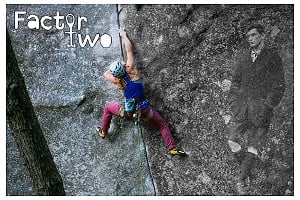
 Over the last few months the UKC Test Team have been putting six pairs of half ropes through their paces. Though they're all good, we came to an easy consensus on our favourites.
Over the last few months the UKC Test Team have been putting six pairs of half ropes through their paces. Though they're all good, we came to an easy consensus on our favourites.Read more
I know I'm being picky here, and it's not directly relevant to the review, but Wrinkled Wall, especially with the runners used in that photo, does not show the need for double ropes. Could have used a better example, Congo Corner for instance
> I know I'm being picky here, and it's not directly relevant to the review, but Wrinkled Wall, especially with the runners used in that photo, does not show the need for double ropes. Could have used a better example, Congo Corner for instance
Well it is small point, but I disagree with it. Double ropes aren't just about zig-zagging route lines, although having everything in that photo on one rope would have been a bit contorted. However the two runners in the lower break are marginal and splitting them between two ropes is an essential application of double rope technique. Admittedly, I'd probably have hit the floor before they caught but they would probably have stopped me rolling down the hill!
Alan
One thing that strikes me about this test, is that with 4 of the 6 ropes, there's a comment relating to some extra care being needed when either belaying or abseiling.
Do we need a bit more joined up thinking between manufacturers? Whats the good of making ropes or belay devices that don't work very well with each other.
Fair enough, the marginality of the lower break runners is impossible to convey without a close-up, and presumably they aren't opposable.
I still love the single rope up Accessory Chimney photo (presumably staged) in the TradClimbing rockfax
> I still love the single rope up Accessory Chimney photo (presumably staged) in the TradClimbing rockfax
Ha yes, not staged honest! Chris Craggs snapped it one day in passing.
Alan
I'd always assumed it was staged. It's a joy to know that it's real.
Manufacturers make a range of different ropes and belay devices, some of which are better suited to some types of climbing then others. It's up to the climber to choose which combination works best for their purposes.
It is possible that the best solution will involve a compromise requiring extra care.
> One thing that strikes me about this test, is that with 4 of the 6 ropes, there's a comment relating to some extra care being needed when either belaying or abseiling.
> Do we need a bit more joined up thinking between manufacturers? Whats the good of making ropes or belay devices that don't work very well with each other.
In this case the ropes were all brand new and quite thin. I think it was just a bit of an eye-opener for those of us who have been using an old pair of 9's for the last few years at how much things have moved on. I don't recall them ever really being dangerously slick, it is just good to be aware.
The only dodgy moment was for me and Ramon on Central Pillar, Esk Buttress, when he looked at my knot on the tie-in knot before the last pitch and pointed out how open it was. I glanced at his and noticed the same. Both of us use bowlines so there is something to be said for a figure-of-8 with a thin new rope.
Alan
May have missed it in the article, but would be interesting to have some comparison on the production in terms of sustainability. I think edelrid ropes have bluesign certification, but not sure if any of the others reviewed here do.
The Mammut Genesis is also bluesign approved. Don't know about the others.
> In this case the ropes were all brand new and quite thin. I think it was just a bit of an eye-opener for those of us who have been using an old pair of 9's for the last few years at how much things have moved on. I don't recall them ever really being dangerously slick, it is just good to be aware.
> The only dodgy moment was for me and Ramon on Central Pillar, Esk Buttress, when he looked at my knot on the tie-in knot before the last pitch and pointed out how open it was. I glanced at his and noticed the same. Both of us use bowlines so there is something to be said for a figure-of-8 with a thin new rope.
The only time I’ve ever had a knot come partially undone is when climbing on brand new ropes. On that occasion it was a figure of eight.
Im always surprised at little care some (often very expirenced and technically capable) climbers take to their knots. Whatever knot I tie on with (I flip between bowlines and figure eights) I always make a point of making sure the knot is well dressed. I then Individually weld each of the four strands that exits the knot. I then tie a stopper knot and weld that too.
Tieing on with neat well dressed knots is something I always emphasise when teaching climbing.
> The only time I’ve ever had a knot come partially undone is when climbing on brand new ropes. On that occasion it was a figure of eight. <
A good feature of the fig 8 is it seems to hold under load when inadequately tied (at least when not cross loaded which could occur with some uses eg as a belay loop). I didn't believe this but tried and it does hold even after just the first bit of the follow through. This is presumably why some say one doesn't need to use a stopper knot (if the loop will only take a unidirectional load).
> Im always surprised at little care some (often very expirenced and technically capable) climbers take to their knots. .... I always make a point of making sure the knot is well dressed. ... <
Agree. Something I've been guilty of. (Also I've read a poorly tied fig 8 can be considerably weaker. However in practice these knots don't break and not slipping undone is the important factor.)
The strength of a fig 8 depends on how it's tied. Presumably it's making sure the first bend on the live end is on the outside of the knot rather than the inside (tighter radii means weaker).
However I vaguely remember seeing some figures years ago that said something like 66% and 60% of the rope's breaking strain (with bowline being somewhere in the middle). So it doesn't actually make any significant difference.
In reality, any knot that doesn't come undone will do, because if forces are high enough to break a rope at a knot, then you are in deep s**t and almost certainly something else will have already failed.
Of course some knots (especially after loading) are easier to undo than others
> Tieing on with neat well dressed knots is something I always emphasise when teaching climbing.
I think that is the point here Tom. I am very careful with my knot as well but, three pitches up, both knots in these shiny new thin ropes had worked loose in a way that I haven't noticed with other ropes. Ramon and myself experienced the same thing - that's four knots!
Having said that, all four knots were still perfectly safe, but they were obviously looser than ideal.
Alan
Knots coming undo on brand new ropes are not a 'new' occurrence. I once watched a bowline nearly come apart on a friends harness in the late 1990's. The stopper had probably already come partly undone while he was leading, and the main knot 'loosened'. He was using the bight as a belay loop and as clip in point to his anchors so there was a degree of cross-load. The 'rabbit' started to pull through the 'hole', at a smooth, steady and alarming rate. Lucky we both spotted it simultaneously.
As we were sitting on top of the fin at Lower Sharpnose as the last route of the day, with an incoming tide, the consequences if it had carried on and his second fell, would have been dire.
His second refused to believe the story assuming he had messed-up the knot, and if I recall correctly, refused to climb with him ever again. If I hadn't seen it happen I would have been very 'skeptical'.
So I too am very careful with 'dressing' knots, doubly so with new ropes. Ever since I've always occasionally checked with the odd glance mid pitch, and always check my knots after any sort of 'squirm' or 'thrutch' entertainment.
I was quite surprised to hear that the Oxygen's got in a tangle. I have had a pair for nearly a year now and used in lots of different situations including plenty of multipitches and never had a particular problem with tangling.
They seem to be holding up well and I really like their handling vs. my old Genesis.
I remember looking down on the very last move of Troutdale Pinnacle, stepping from the pillar into the wall, to see my bowline, stopper knot and all, having completely undone itself and being just the rope through my harness. That was on a new Genesis 8 years ago or so. Eye opening experience!
Has the mammut Genesis changed? I've been using them at that diameter fwwell over a decade: I'm amazed it still seems to provide the best combination of weight and durability. You'd think that by now someone could have produced a rope that was just as durable, without too much stretch but significantly lighter.
Or have they, and the Genesis is actually better than it was 10 years ago?
At one time it was so simple as there was only Viking 1,2 3 or 4 hawser, so it was a choice of using two 3's or one 4!
They sold the rope business to Teufelberger in 2016, who took the factory and moved it. I’ve no idea whether that has changed the product though.
> A good feature of the fig 8 is [...] This is presumably why some say one doesn't need to use a stopper knot
I'm pretty sure that you don't need a stopper knot for the fig 8, and I'd be surprised if anyone claimed that you do. The stopper knot is really there only for neatness of the tail.
I agree with you and don't always use a stopper with a fig 8 knot unless the tail is a bit long. The review of the Petzyl rope did suggest using a stopper (when new) as there was a tendency for the knot to loosen, which seems to make sense especially on a long multipitch.
There might be an issue if the loop is used for additional purposes eg attaching belay device or krab(s) with attachments to anchor points as one can envisage a situation where multidirectional loading might pull the knot apart. However personally I have no evidence that this happens. ( I think the danger of the figure of 8 pulling apart when joining ab ropes concerned tying it with the ropes running in opposite directions with a tail at each end.)
Incidentally when doing the cursory initial "belay test" at an indoor wall they did insist on a stopper knot. Of course if not snug with the main knot this might lead to mistakenly clipping the belay device etc on the wrong side of the main knot with possible unfortunate consequences...








